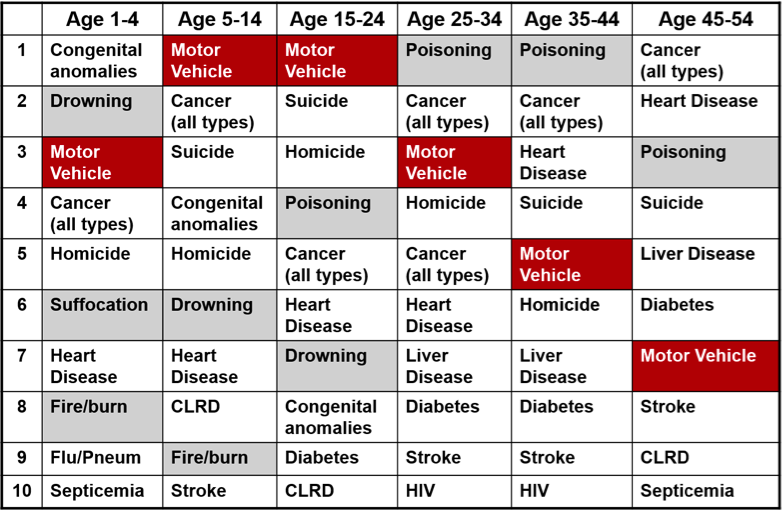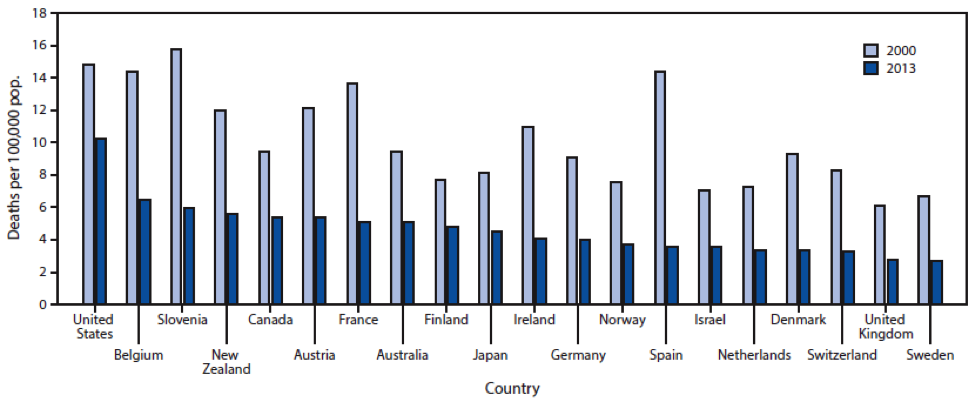For the first time since recordkeeping began over a hundred years ago, unintentional injury has catapulted to the #3 overall cause of death for Americans. Motor vehicle crashes are a top cause of unintentional death throughout our lives. However they disproportionately affect children and young adults, meaning they take lives of those who have the most life left to live. Despite the fact that over the last hundred years we have increased safety in the cars we drive and studied what causes crashes, we are still moving in the wrong direction when it comes to volume of motor vehicle deaths.

Figure 1 Comparison of Preventable Causes with Other Leading Causes of Death, 2016. Source: NSC Analysis of NCHS Data
Today, motor vehicle crashes are also the leading cause of fatalities in the workplace. Our cultural Novocain regarding roadway fatalities has yet to wear off, but making headway in transportation safety is far from impossible. In the last century, working on the railroad has gone from one of the deadliest jobs – with thousands of rail worker deaths a year – to an industry with fewer than twenty on-the-job fatalities annually as a result of significant commitment to send every employee home safely. In the last two decades we have seen commercial aviation transform. In the 1990s there was an average of one or two domestic airline crashes a year. Due to critical interventions by aviation stakeholders, we haven’t had a scheduled U.S. passenger aviation fatal crash since Continental 3407 in Buffalo in 2009.
The Road to Zero Coalition was announced in 2016 with a vision of eliminating roadway fatalities by 2050. Beginning with the premise that zero was the right goal, the Coalition follows in the footsteps of Towards Zero Deaths and Vision Zero programs. Working in concert with road safety researchers and experts, the 500+ member-strong Coalition has created a blueprint to help identify obstacles and opportunities on the road towards zero roadway fatalities. The soon-to-be released Road to Zero report identifies three major actions needed to get us to zero: double down on what works, accelerate promising technology, and prioritize safety through culture change and a safe system approach.
Doubling down on what works begins with refocusing on successful traffic safety strategies that address familiar hazards such as speed, impairment and distraction, but also renewing our commitment to key safety habits like wearing seat belts. To date, tens of thousands of lives have been saved through these measures and doubling down on existing traffic safety actions keeps that momentum moving forward. Advancing proven counter-measures is an obvious step, but the reality is that we have inconsistent applications of best practices meaning that nationwide, we can do better.
Accelerating technology can help drivers avoid dangerous mistakes and assist with safe vehicle operation. If we are to achieve significant, near-term gains in roadway safety, it will require a commitment to advancing, adopting and accelerating technology throughout the fleet. While widespread ownership or use of self-driving cars is decades away, a recent study by Carnegie Mellon found that just three existing technologies could save upwards of 10,000 lives each year – forward collision warning, lane departure warning, and blind spot monitoring.
Accelerating promising technologies, updating our fleets, creating common terminology and educating consumers will pave the way to making crash avoidance an expectation, not a hope. Moreover, the promise of life-saving technology doesn’t end with the vehicle itself, it also applies to the environment and emergency response. Smart grid technologies, automated enforcement, real-time transmission of crash forces, and vital health information for first responders can all reduce the death toll.
Prioritizing Safety in our decision making will drive measurable improvement in outcomes at the national and local level. We demand 100% safe operations in aviation, marine, pipeline, rail, and transit, we should cultivate a corresponding societal demand for safe roads. The U.S. is trailing our international counterparts in addressing road safety.

Figure 2 Motor vehicle crash deaths per 100,000 population — 20 high-income countries, 2000 and 2013. Source: CDC
With a 14% increase in fatalities between 2014 and 2017, immediate improvements are needed to arrest this deadly trend.
Vision Zero cities have saved the lives of vulnerable road users by redesigning dangerous corridors and crash-prone intersections. Infrastructure improvements, automated enforcement, adjusting speed limits, and traffic signal timing have created a safer road environment for the most vulnerable road users such as bicyclists and pedestrians.
We know humans will make mistakes, but a safe system approach ensures that those errors are less likely to result in fatalities. In urban areas, slowing down traffic in high risk areas makes it more likely that pedestrians and bicyclists will survive a collision. Driving down the higher per capita death toll in rural settings will take improving crash notifications, transmitting critical medical and health care information, and creating greater access to trauma centers.
Whether you live in an urban or rural environment, ride a bike, drive a car to work or walk to school, your safety should be prioritized. Over 100 people die every day in motor vehicle crashes on U.S. roadways. Every one of these deaths is preventable. There is not a single person we would willingly sacrifice for the convenience of getting from point A to point B. And there is not a single reason in the world why we cannot get closer to our goal of zero.
Want to stay in touch with Eno? Subscribe to our mailing list!
Want to learn more about joining Eno? Check out our individual and group memberships!





